#alban eilir
Explore tagged Tumblr posts
Text

beautiful red camellias
3 notes
·
View notes
Text
Happy Spring Equinox!
Hello! It’s Tuesday. It’s also the Equinox, Alban Eilir, or, in some traditions, Ostara. (Unless you’re in the southern hemisphere, in which case: Happy Mabon!) This is essentially the second part of the celebrations of spring: Imbolc, the Equinox, and Beltane. If Imbolc is when spring wakes up, the Equinox is when it really gets going, and Beltane is the height of its strength. Since it’s…

View On WordPress
5 notes
·
View notes
Text
🌿☀️ Alban Eilir - The Light of the Earth 🌿☀️
The Spring Equinox, otherwise known as the Vernal Equinox, or Alban Eilir, meaning “Light of the Earth”, will occur in England on Thursday, March 20th. This event is significant in various cultures and traditions, often celebrated as a time of renewal, balance, and new beginnings. 🌸🌞 Some say that this is the start of our New Year because: The days and nights are nearly equal in length (around…
0 notes
Text
#spring equinox#seed planting#renewal rituals#modern spring celebrations#fertility symbols#equinox celebrations#egg decorating#celtic traditions#bonfires#alban eilir
0 notes
Text
March 2025 Witch Guide
New Moon: March 29th
First Quarter: March 6th
Full moon: March 14th
Last Quarter: March 22nd
Sabbats: Ostara- March 20th
March Storm Moon
Also known as: Crow Moon(Ojibwe), Hard Crust on the Snow Moon(Ojibwe & Chippewa tribes near the Great Lakes), Hrethmonath, Lenten Moon, Little Sand Storm Moon(Zuni), Moon of the Whispering Wind(Hopi), Moon When the Leaves Break Forth(Pueblo), Moon of the Winds, Sore Eyes Moon(Sioux, Lakota & Assiniboine of the Great Plains, northern plains, & Dakotas), Sap Moon(Shawnee of Ohio & Pennsylvania), Spring Moon(Inupiat in Alaska & the Passamaquoddy of the northeastern US), Storm Moon, Sugar-Making Moon(Ojibwe of southern Canada), Wind Moon(Choctaw, Cherokee of the southeastern US & the Catawba of South Carolina), & Worm Moon
Element: Water
Zodiac: Pisces & Aries
Nature spirts: Air spirts, water spirts & mer-people
Deities: Artemis, Astarte, Athena, Cybele, Isis, Luna & Minerva
Animals: Boar, cougar & hedgehog
Birds: Sea crow & sea eagle
Colors: Pale green, red-violet & yellow
Trees: Alder, dogwood & honeysuckle
Herbs: Apple blossom, high John root, Irish moss, pennyroyal, wood betony & yellow dock
Flowers: Daffodil, jonquil & violet
Scents: Apple blossom & honeysuckle
Stones: Amethyst, aquamarine, bloodstone, moonstone, obsidian, onyx, red zircon & topaz
Issues, intentions & powers: Astral, banishing, beginnings, empowerment, fertility & purification
Energy: Balance, beginnings, dream work, energy breaking into the open, exploring, growth, inner development, prospering, spirtual debt & truth seeking
March’s full Moon is often called the Worm Moon. It was thought this name referred to the earthworms that appear as the soil warms in spring.
However, In the 1760s, Captain Jonathan Carver visited the Naudowessie (Dakota) & other Native American tribes & wrote that the name Worm Moon refers to a different sort of “worm”—beetle larvae—which begin to emerge from the thawing bark of trees & other winter hideouts at this time.
• Storm moon comes from heavy rains & gray skies abound — the earth is being showered with the life-giving water it needs to have a fertile & healthy growing season. This is also a time of equal parts light & darkness, so a time of balance.
This month's full moon is a blood moon which is a full moon that coincides with a full lunar eclipse. This moon can have an unusually reddish appearance
•There is a partial solar eclipse on March 29th
• There is a total lunar eclipse on March 13-14th depending on where you are
Ostara
Known as: Alban Eilir, Lady Day, Spring Equinox & Vernal Equinox
Season: Spring
Element: Fire
Symbols: 8-Spoked wheel, butterflies, chicks, decorated baskets, eggs, feathers, hares, rabbits, seeds, shamrocks, spring flowers & sunwheels
Colors: Green, light-blue, indigo, pink, red, silver, violet, white & yellow
Oils/Incense: African violet, apple blossom, columbine, crocus, daffodil, daisy, florals, ginger, honey, honeysuckle, jasmine, jonquil, lilac, lotus, magnolia, narcissus, orange blossom, primrose, rain, rose, sage & strawberry
Animals: Bees, boar, butterflies, hare, hedgehogs, horse, rabbit, ram, sheep & snake
Birds: Chicks, cormorant, hawk, robin, sparrow & swallow
Stones: Amethyst, aquamarine, bloodstone, moonstone, red jasper & rose quartz
Mythical: Pooka & phoenix
Food: Asparagus, dairy foods, dill, eggs, fruit, honey, honey-cakes, lamb, leafy green vegetables, mead, pine nuts, pumpkin, radish, seafoods, spring onions, sprouts & sunflower seeds
Herbs/Plants: Acorn, broom, ginger, gorse, hyssop, high John root, Irish Moss, lemon grass, olive, strawberry, woodruff
Flowers: Apple blossom, columbine, crocus, daffodil, dandelion, daisy, honeysuckle, iris, jasmine, jonquil, lilac, lily, linden, orange blossom, narcissus, peony, primrose, rose, snowdrop, tansy, tulip, violet
Trees: Alder, apple, ash, birch, dogwood, hawthorn, maple, yew
Goddesses: Aphrodite, Amalthea, Ariadne, Artemis, Astarte, Athena, Blodewedd, Coatlicue, Cybele, Demeter, Diana, Eos, Epona, Flora, Freya, Gaia, Guinevere, Hera, Idunn, Iris, Ishtar, Isis, Juno, Libera, Maia, Minerva, Ostara, Persephone, Rati, Renpet, Umaj, Venus, Vesta & Vila
Gods: Adonis, Aengus MacOg, Attis, Celi, Cernunnos, Coel, Dalon ap Landu, The Dagda, Dumuzi, Eros, The Green Man, Kama, Mithras, Odin, Osiris, Ovis, Pan & Thor
Tarot cards: The Empress, The Fool, The Magician, The Priestess, Strength, Justice & The Star
Spellwork: Altar rededication, beginnings, fire magick, new employment & new projects
Issues, Intentions & Powers: Agriculture, balance, beauty, fertility, growth, life, light, love, rebirth & renewal
Activities:
•Go on a hike/walk & look for signs of spring
• Add Ostara symbols to decorate your altar space
• Plant vegetable &/or flower seedlings indoors after blessing the seeds
• Color bight, decorate & hunt eggs
• Set your intentions for the weeks/months ahead
• Start a new class or hobby
• Create eggshell candles
• Make plans & new routines for the future
• Participate in rituals & ceremonies that connect you with energy & the life force of nature
• Have a feast with your friends &/family with sprouts & leafy greens
• Bake hot cross buns
• Clean & de-clutter your home
• Try a re-birthing/ renewing ritual
• Bring fresh flowers or plants into into the home
• Host a spring & floral themed tea party
• Make egg based food dishes & desserts
• Assist houseless individuals as most temporary shelters will soon be closing
Ostara gets it's name from Eostre, however the celebration isn't based on her even though she is said to be interpreted as the goddess of spring, fertility & the dawn. There is very little information on Eostre and none have shown up before the eighth century because of disagreements on she had Celtic or Germanic origins.
People tend to believe Ostara is an ancient holiday at it's core with an ancient goddess, but that may not be the truth. While most gods & goddesses have many myths & stories surrounding them, the same cannot be said about Eostre
It is still up for debate whether or not this goddess ever existed or if she was revered & celebrated the ways she's been in the more recent years.
•Like many other spring celebrations in other cultures, Ostara symbolizes fertility, rebirth & renewal. This time of year marking the beginning of the agricultural cycle when farmers would start planting seeds.
There is no evidence that the ancient Greeks or Romans celebrated Ostara, although they did celebrate their own spring festivals, such as the Roman festival of Floralia & the Greek festival of Anthesteria. It was a time to honor the returning sun, fertility & rebirth.
Related festivals:
• Nowruz: March 20h-
Nowruz marks the first day of spring & renewal of nature. It is celebrated on the day of the astronomical vernal equinox. It is also celebrated as the beginning of the new year by people all around the world for over 3,000 years in the Balkans, the Black Sea Basin, the Caucasus, Central Asia, the Middle East & other regions.
It promotes values of peace & solidarity between generations & within families as well as reconciliation & neighbourliness. Nowruz plays a significant role in strengthening the ties among peoples based on mutual respect & the ideals of peace and good neighbourliness.
Traditional customs of Nowruz include fire & water, ritual dances, gift exchanges, reciting poetry, symbolic objects & more; these customs differ between the diverse peoples & countries that celebrate the festival.
• Holi: March 14th-
Holi is a popular & significant Hindu festival celebrated as the The festival of colors, Love &Spring. It commemorates eternal and divine love of the deities Radha & Krishna. Additionally, the day signifies the triumph of good over evil, as it celebratess the victory of Vishnu as Narasimha over Hiranyakashipu. Holi originated & is predominantly celebrated in the Indian subcontinent, but has also spread to other regions of Asia & parts of the Western world through the Indian diaspora.
The festival has many purposes; most prominently, it celebrates the beginning of spring. In 17th century literature, it was identified as a festival that celebrated agriculture, commemorated good spring harvests & the fertile land. It's believed to be a time to enjoying spring's abundant colours & say farewell to winter. To many Hindus, Holi festivities mark an occasion to reset & renew ruptured relationships, end conflicts, & rid themselves of accumulated emotional impurities from the past
It also has a religious purpose, symbolically signified by the legend of Holika. The night before Holi, bonfires are lit in a ceremony known as Holika Dahan (burning of Holika) or Little Holi. People gather near fires, sing & dance. The next day, Holi, also known as Dhuli in Sanskrit, or Dhulheti, Dhulandi or Dhulendi, is celebrated.
•Easter: April 20th-
Also called Pascha or Resurrection Sunday, is a Christian festival & cultural holiday commemorating the resurrection of Jesus from the dead, described in the New Testament as having occurred on the third day of his burial following his crucifixion by the Romans at Calvary c. 30 AD. It is the culmination of the Passion of Jesus Christ, preceded by Lent (or Great Lent), a 40-day period of fasting, prayer, & penance.
Easter traditions vary across the Christian world & include sunrise services or late-night vigils, exclamations & exchanges of Paschal greetings, flowering the cross & the decoration and the communal breaking of Easter eggs (a symbol of the empty tomb) among many others. The Easter lily is a symbol of the resurrection in Western Christianity traditionally decorates the chancel area of churches on this day & for the rest of Eastertide. Additional customs that have become associated with Easter & are observed by both Christians & some non-Christians include Easter parades, communal dancing, the Easter Bunny & egg hunting.
Other celebrations:
• Festival of Luna: March 31st-
Is a feast day honoring the Goddess Luna who is seen as the divine embodiment of the Moon.
The Temple of Luna was a temple on the Aventine Hill in Rome, dedicated to Luna, the moon goddess. Its dedication was celebrated on March 31st, thus the celebration.
According to Tacitus, it was built by king Servius Tullius. However, the first confirmed reference to a temple to Luna dates to 182 BC & refers to one of its doors being knocked off its posts by a miraculous blast of air & shot into the back of the Temple of Ceres. That account probably places the temple at the north end of the hill, just above porta Trigemina. The temple was struck by lightning around the time of the death of Cinna, as was the temple of Ceres. After the destruction of Corinth, Lucius Mummius Achaicus dedicated some of his spoils from the city to this temple. It was destroyed in the Great Fire of Rome in 64 AD & not rebuilt.
Sources:
Farmersalmanac .com
Llewellyn's Complete Book of Correspondences by Sandra Kines
Wikipedia
Encyclopedia Britannica
A Witch's Book of Correspondences by Viktorija Briggs
Encyclopedia britannica
Llewellyn 2025 magical almanac Practical magic for everyday living
https://www.learnreligions.com
Llewellyn's Sabbat Essentials: Ostara
#witchblr#wiccablr#paganblr#spirtual#witches of tumblr#tumblr witches#witch community#witchcore#March 2025#witch guide#worm moon#wheel of the year#ostara#spring equinox#witchcraft#grimoire#book of shadows#spellbook#witch tips#baby witch#beginner witch#witchy things#witch friends#witch#sabbat#witches#witchy stuff#beginner witch tips#baby witch tips#witchlife
118 notes
·
View notes
Text

From Stagwarlock Instagram:
Wake up Ô Cernunnos and enlight your wild sons, it’s Alban Eilir
The name for the festival of the Spring Equinox in Druidry is Alban Eilir, which means 'The Light of the Earth'.
8 notes
·
View notes
Text
31 Days of Sean MacGuire Spells Challenge

Happy Heritage Month, Celtic witches!
Leprechaun Day. The Sean MacGuire correspondence charts masterpost is posted.
Shamrock Day. A lucky charm spell is posted.
Greenery Day. A list of organizations dedicated to preserving Ireland's (and also the world's) environment is posted.
Pot o' Gold Day. A spell to attract wealth is posted.
Celtic Cross Day. An exorcism against negativity and negative spirits spell is posted.
Harp Day. A hymn praising springtime is posted.
Blarney Stone Day. A spell to bestow the gift of gab is posted.
Four-Leaf Clover Day. Another lucky charm spell is posted.
Rainbow Day. A spell to keep hope alive during these times is posted.
Claddagh Ring Day. A spell to attract friends is posted.
Morning Dew Day. What the title says — a list of things you can do with morning dew is posted.
Irish Terrier Day. A protection spell is posted.
Guinness Day. A toast to all good things spell is posted.
Celtic Knots Day. A list of Celtic knots, what they mean, and how they're used in witchcraft is posted.
Wheel of Fortune Day. Another lucky charm spell is posted.
Irish Whiskey Day. A potion recipe is posted.
All Snakes Day. A healing spell utilizing snakeskin and herbalism is posted.
Reblog Day. A Sean MacGuire or Sean-related post is reblogged.
Tree of Life Day. A list of Celtic trees, what they mean, and how they're used in witchcraft is posted.
Alban Eilir Day. A ritual for Alban Eilir is posted.
Spring Fairy Fun Day. A fae magic spell is posted.
Horseshoe Day. Another lucky charm spell is posted.
Druid Day. A guide to basic druidry is posted.
Reblog Day. A Sean MacGuire or Sean-related post is reblogged.
Emerald Day. A list of Celtic gemstones, what they mean, and how they're used in witchcraft is posted.
Acorn Day. A list of things to do for spoonie witches and witches who are on a budget is posted.
Awen Day. A spell to help with writer's block is posted.
Shillelagh Day. A jinx spell to bring bad luck to a friend on April Fools.
Lucky Charms Day. Lucky charm masterpost is reblogged.
White Rabbit Day. A spell for the seven heavenly virtues is posted.
Prank Day. A list of ideas to do on April Fools is posted.
#bookofleprechaun#sean macguire#rdr2 sean#red dead redemption sean#pop culture clown witchcraft#pop culture witchcraft
9 notes
·
View notes
Text
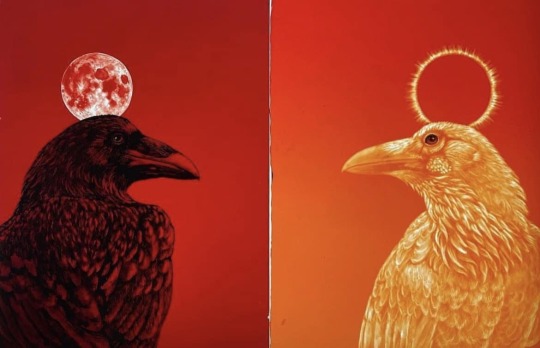
( Artist credit: Tasmin Abbott )
* * * *
If ever you’d like to delve deeper into the ancestral lore of the British Isles & under stand some of its indigenous foundations, I feel it is the most directly accessible in the gateway of the spring equinox (which rings in this Wed 20th March) other wise known in Scots Gaelic as Alban Eilir, the ‘light of the earth’ when the light of the sun meets in equal hours with the night
The myths & lore are interwoven so intricately in the landscape this time of year. Here it is in a nutshell for you to absorb. But it truly is a nutshell as each part is deserving an immense investigation & study to take you further into the heart of it all:
~ TOWER HILL: The spring equinox still today is honoured by the Druids on Tower Hill in London. An ancient ancestral mound once known as ‘Bryn Gwyn’, which translates to White Mound or White Raven. It visually used to look like Silbury Hill a neolithic hill in the Avebury complex in Wiltshire, & was covered in a white chalk which reflected in the moon & sunlight & could be seen for miles. The White Mound is the sacred mound of Sovereignty of this isle, a place where our ancestors would pilgrimage to from far & wide
~ RAVEN: The raven is the bird & protector of the spirit of Sovereignty of the British Isles & has done for millennia. Raven veneration goes back very far in this country’s lore & is deeply rooted in it’s soul’s foundations. An ancient ancestor of this isle called Bran the Blessed, a Welsh King who you could say presides over this gateway because his lore is so interwoven into the landscape this time of year. Bran means ‘Raven’ in Welsh, who was seen as a seer & oracular king bridging the worlds of the gods & earth like his divine messenger feathered friends. Story goes that on his death bed in battle he asked for his head to be buried in the White Mound in London in protection of the Sovereignty of this isle. The ravens in the tower of London today, hold the lore & protective forces of Bran. The fact that the raven is the animal of sovereignty of this isle…tells you everything you need to understand about this island & it’s essence. It is one of magic & deep seership
~ SOVEREIGNTY: You see in the sovereign codes of olde in kingship, that in maintaining balance in your kingdom you married yourself to the earth in an alliance for true balance. Your sovereignty was infused with the earth (the goddess) and the minute that allegiance was severed a wasteland would take seed in the land and all hearts. For Bran to ask for his head to be buried in the White Mound even at death shows his complete allegiance to the earth and understanding of what it means to be Sovereign. The olde understanding is to be in Service to the All, in allegiance with the earth and protection of the goddess. When the Druids stand on Tower Hill, they are welcoming back the sovereign sun during the tide of the equinox but they are also invoking the ancient powers of sovereignty in the land. And of Bran.
~ BRIDGING: In one of the stories of Bran, his sister Branwen (which means ‘white raven’) is abused by her husband who is an Irish King. Bran hears of the news and crosses the Irish seas, by using his body as a bridge for his men to cross over him safely across the stormy seas to help him set his sister free. He was always seen as a king who sought to bring enemies into peaceful accord with one another, and therefore may represent the balance implicit in the equinox as well.
~ ALDER: Bran carries alder branches on his journey to rescue his sister. People recognise him by the alder that he holds. He is known as the alder king. Alder trees are indeed ‘bridging’ trees which preside over the realms of water and fire; the conscious and unconscious. The inner and outer. In the tree ogham it resides between the astrological zodiac signs of pisces and aries, emerging from the watery fluid time of Pisces and entering the fiery intensity of Aries. It is a water resistant wood which gets harder in water and was widely used to build the city of Venice. It is connected to the realms of fire, due to it’s ability to create very high quality charcoal and gun powder. It holds the ancient alchemical colours of white and red in it’s wood. It’s wood is a beautiful white colour but when cut or it’s roots exposed to the air it turns a bright red colour. The white is representative of the moon, the water, Branwen the white raven. And red, being the sun, the fire of the coals of gunpowder, Bran the solar deity king. It possesses both female and male catkins on the same branch - a tree that symbolises the balance between the masculine and the feminine, day and night.
In essence the gateway of the vernal equinox is deeply coded in the earth and lore of the land: Reminding us in order to keep balance within and without ~ true Sovereignty must be upheld, and that it is in an alliance with the earth and in service to all.
That sovereignty is restored when we act as a bridge in the world; remembering the essence of our humanity in bringing heaven to earth as bridges. Akin to the raven messengers who bring the words from the gods into the human world. And the alder trees who bridge the worlds of water and fire.
[Thank you Charlotte Pulver]
12 notes
·
View notes
Text
Pagan Holidays
Origin
The Wheel of the Year is an annual cycle of seasonal festivals, observed by many pagans, consisting of the year's main solar events, solstices and equinoxes, and the midpoints between them. While names for each festival vary among diverse pagan traditions, they often refer to the four solar events as "quarter days", with the four midpoint events as "cross-quarter days". Observing the cycle of the seasons has been important to many people, both ancient and modern. Contemporary Pagan festivals that rely on the Wheel are based to varying degrees on folk traditions, regardless of actual historical pagan practices. Among Wiccans, each festival is also referred to as a Sabbat, based on Gerald Gardner's view that the term was passed down from the Middle Ages. Modern conceptions of the Wheel of the Year calendar are heavily influenced by mid-20th century british paganism. Historical and archaeological evidence suggests ancient pagan and polytheist peoples varied in their cultural observations; Anglo-Saxons celebrated the solstices and equinoxes, while Celts celebrated the seasonal divisions with various fire festivals.
Dates and Offerings
Dates may be on the days of the quarter and cross-quarter days proper, the nearest full moon, the nearest new moon, or the nearest weekend for secular convenience. The festivals were originally celebrated by peoples in the middle latitudes of the Northern Hemisphere. Consequently, the traditional times for seasonal celebrations do not agree with the seasons in the Southern Hemisphere or near the equator. Pagans in the Southern Hemisphere often advance the dates 6 months to coincide with their seasons. Offerings of food, drink, various objects, etc. have been central in ritual to and for deities for millennia. Modern pagan practice strongly avoids sacrificing animals in favour of grains, herbs, milk, wines, incense, baked goods, minerals, etc. Burying and leaving offerings in the open are also common in certain circumstances. The purpose of offering is to benefit the deity, show gratitude, and give something back, strengthening the bonds between humans and divine and between members of a community.
Festivals
Winter Solstice (Yule, Saturnalia, Midwinter)
Midwinter, known commonly as Yule or within modern Druid traditions as Alban Arthan, has been recognised as a significant turning point in the yearly cycle since the late Stone Age. The reversal of the Sun's ebbing presence in the sky symbolizes the rebirth of the solar god and foretells the return of fertile seasons. From Germanic to Roman tradition, this is the most important time of celebration. Practices may vary but common offerings, feasting, and gift giving are common elements of Midwinter festivities. Bringing sprigs and wreaths of evergreenery (such as holly, ivy, mistletoe, yew, and pine) into the home and tree decorating are also common during this time.
Imbolc (Candlemas)
The cross-quarter day following Midwinter falls on the first of February and traditionally marks the first stirrings of spring. It aligns with the contemporary observance of Groundhog Day. It is time for purification and spring cleaning in anticipation of the year's new life. For Celtic pagans, the festival is dedicated to the goddess Brigid, daughter of The Dagda and one of the Tuatha Dé Danann. Among Reclaiming tradition Witches, this is the traditional time for pledges and rededications for the coming year.
Spring Equinox (Ostara)
Derived from a reconstruction produced by linguist Jacob Grimm of an Old High German form of the Old English goddess name Ēostre, Ostara marks the spring equinox in some modern Pagan traditions. Known as Alban Eilir to modern Druid traditions, this holiday is the second of three spring celebrations, the midpoint between Imbolc and Beltane, during which light and darkness are again in balance, with light on the rise. It is a time of new beginnings and of life emerging further from the hold of winter.
Beltane (May Eve)
Traditionally the first day of summer in Ireland, in Rome the earliest celebrations appeared in pre-Christian times with the festival of Flora, the Roman goddess of flowers. Since the Christianisation of Europe, a more secular version of the festival has continued in Europe and America, commonly referred to as May Day. In this form, it is well known for maypole dancing and the crowning of the Queen of the May. Celebrated by many pagan traditions, this festival recognizes the power of life in its fullness, the greening of the world, youthfulness and flourishing.
Summer Solstice (Litha)
Midsummer is one of the four solar holidays and is considered the turning point at which summer reaches its height and the sun shines longest. Among the Wiccan sabbats, Midsummer is preceded by Beltane, and followed by Lammas or Lughnasadh. Bede writes that Litha means gentle or navigable, because in both these months the calm breezes are gentle and they were wont to sail upon the smooth sea. The sun in its greatest strength is greeted and celebrated on this holiday. While it is the time of greatest strength of the solar current, it also marks a turning point, for the sun also begins its time of decline as the wheel of the year turns.
Lughnasadh (Lammas)
Lammas or Lughnasadh is the first of the three Wiccan harvest festivals, the other two being the autumnal equinox, or Mabon, and Samhain. Wiccans mark the holiday by baking a figure of the god in bread and eating it, to symbolise the sanctity and importance of the harvest. The Irish name Lughnasadh is used in some traditions to designate this holiday. Wiccan celebrations of this holiday are neither generally based on Celtic culture nor centered on the Celtic deity Lugh. This name seems to have been a late adoption among Wiccans. In early versions of Wiccan literature the festival is referred to as August Eve. The name Lammas implies it is an agrarian-based festival and feast of thanksgiving for grain and bread, which symbolises the first fruits of the harvest.
Autumn Equinox (Mabon)
The holiday of the autumnal equinox, Harvest Home, Mabon, the Feast of the Ingathering is a modern Pagan ritual of thanksgiving for the fruits of the earth and a recognition of the need to share them to secure the blessings of the Goddess and the Gods during the coming winter months. The name Mabon was coined by Aidan Kelly around 1970 as a reference to Mabon ap Modron, a character from Welsh mythology. Among the sabbats, it is the second of the three Pagan harvest festivals.
Samhain
Samhain is one of the four Greater Sabbats among Wiccans and Pagans. Samhain is typically considered as a time to celebrate the lives of those who have passed on, and it often involves paying respect to ancestors, family members, friends, pets, and other loved ones who have died. Aligned with the contemporary observance of Halloween and Day of the Dead, in some traditions the spirits of the departed are invited to attend the festivities. It is seen as a festival of darkness, which is balanced at the opposite point of the Wheel by the festival of Beltane, which is celebrated as a festival of light and fertility. Many Neopagans believe that the veil between this world and the afterlife is at its thinnest point of the year at Samhain, making it easier to communicate with those who have departed.
Dates
Yule~ December 20-23
Imbolc~ February 1
Ostara~ March 19-22
Beltane~ May 1
Litha~ June 19-23
Lughnasadh~ August 1
Mabon~ September 21-24
Samhain~ October 31- November 1
#divination#greek mythology#norse#norse mythology#pagan#pagan witch#spirituality#witch community#witchblr#grimoire#pagan holidays#festival
3 notes
·
View notes
Text




daffodil season
3 notes
·
View notes
Text
Happy Alban Eilir - Spring Equinox
As we transition into spring, I'd like to take a moment to express what the spring equinox means to me. It is said that it represents balance, renewal, and rebirth, and I couldn't agree more with that. This year has, in a sense, been a rebirth for me as a whole. I've just gotten into Celtic Paganism/Druidry, and my life has changed drastically in such a short time for the better. I feel in balance with myself for the first time in my life. Just as the flowers bloom, so do I. My smile and energy radiate with the rays of the sun. My body feels like it's risen from the ground, as a new-born tree does. I can feel everything around me so much better than I ever could before. I have returned to my trees as they would.
For anyone struggling right now, remember that it is only temporary. Just as the seasons change, you too will bloom and be reborn again. Keep fighting for a better tomorrow and keep working to improve yourself, no matter what. No matter how big or small, It all matters. Listen to the call of nature, and it will guide you.
#druidism#druidry#nature#self discovery#celtic paganism#spring equinox#healing#mental health#paganism#balance
4 notes
·
View notes
Text
He had to be ready by Spring Equinox. The Druids would be celebrating Alban Eilir, one of many little rituals and celebrations they had over the year. But this one, 'The Light of the Earth', was a perfect metaphor for a proposal and only the ring was ready for the day. Or, it had been before Aren changed his mind about something in the design and was getting a part of it redone while also managing the druid lessons, his new part-time job and worrying about Octavian and Oztalun's every move. "What are you talking about? I have tons of Archdruid responsiblities," he argued playfully, looking through his closet while his mind was also on phone call that he had to make privately about the ring once he left Evy. Though it was true Andreas no longer had to worry about Oztalun's tree or Senate politics, both the bulk of what had been his responsibilities, his wayward brain made his mornings chaotic as though he had a million things to do. "I can't find... fucking christ, how many robes did I own?" He tossed 10th century BCE furs to the side of the floor. "Do you know where I put that black jacket with the, err," he mimed a hood to Evy, the word not coming to him in that moment. (The jacket was hung on the door a few meters away.) "Anyway, I have work in two hours and then I have to go check on Valsharra in the Fey Forest... make sure she hasn't eaten any people, say hi, then come back home on time for dinner with you. Very busy. Very much Archdruid responsibilities."

who? @destinedgray where? aren's private chambers notes: doing the randomize top songs thing and got genius by written by wolves

"For some who no longer has Archdruid responsibilities, you seem mighty busy lately," Evy coos playfully as she leans against the head of their bed, eyes alight with mischief as her gaze follows Andreas as he moves around the room. She knows, without a shadow of doubt, that he is up to something. She is very sure of what that something it's too, the tabs on his phone looking for jewelers and the sneakiness adding together with their conversation right before the war had begun.
#// this is an accurate representation of every one of my mornings without meds#// so it became long#interactions ♔ (history has its eyes on you.)#& evelina#& evelina 014
1 note
·
View note
Text
Happy Spring Equinox 2023!
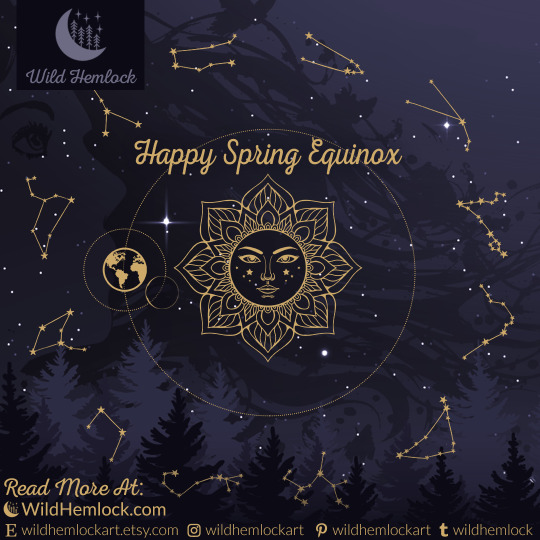
Happy First Day of Spring! or Vernal Equinox, a milestone of the Earth’s revolution around the sun. The day and night cycle is close to equal – about 12 hours and 10 minutes of sunlight here in Western Pennsylvania today. Today is halfway between the [approximately] longest day of the year in June and the shortest day in December. Flora and fauna are waking from their winter dormancy.
During the Equinox, the Sun’s Ecliptic Pathway crosses the Celestial Equator, as per the Glossary of Astronomical Phenomena:
Vernal Equinox – The intersection of the celestial equator and the sun’s ecliptic pathway in it’s northern ascent towards the tropic of Cancer. At this time, the Earth’s axial tilt is facing neither toward nor away from the sun, and there is approximately 12 hours of daylight and nighttime. This marks the beginning of the spring season in the northern hemisphere.

Right now, night is receding and making way for longer, warmer days. It is time to get outside and enjoy it!
Click Here to Learn More at WildHemlock.Com!
#spring equinox#first day of spring#spring#springtime#vernal#vernal equinox#ostara#eostre#disablot#Alban Eilir#witchblr#astronomy#witchy#baby witch#celestial#space#astrology#moon child#outer space#space witch#beginner witch#astro notes#astrologer#cosmic#cosmic witch#whimsigoth#astrological new year#sun and moon#astro community#zodiac
74 notes
·
View notes
Text
Sukellos -Sucellos
God of Gaulish Celtic Mythology
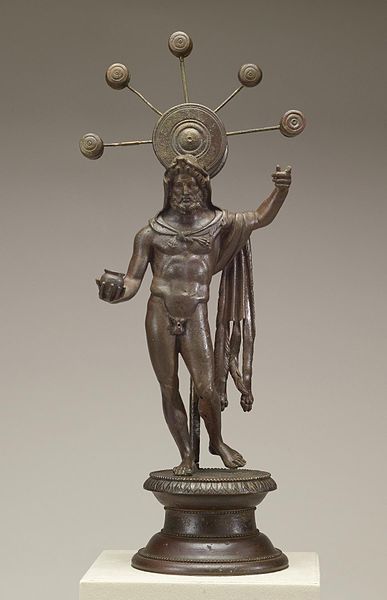
Walters Art Museum in Baltimore, United States of America ( This statue of Sucellus is the earliest known depiction of the god (circa 1st century AD). It was found in a Roman dwelling in France and stood in a private sanctuary (lararium).
Celtic god of agriculture,
forests and alcohol...
Characteristics
Latin name: Sucellus
Main function: God of life, death, crops and flocks
Place of origin: Gaul
Period of Origin: Celtic and Gallic Antiquity
Paredre: Nantosuelte - Nantosuelta
Equivalent(s): by syncretism Dagda, Sylvain, Thor[1]Symbols.
The name of the god is said to mean "good hitter" or "hit hard". The theonym is composed of the prefix su- which means "good, good" and cellos which designates the hammer (or striker)[3].
Judging by the number of his representations (more than 200), Sucellus is one of the greatest Gallic gods[4].

bronze statuette at the National Archeology Museum in Paris.
This god is known mainly in Gaul and all the elements concerning him (representation on a Unelles coin, some inscriptions and bronze statuettes) are from the Gallo-Roman period.
He appears to be old and bearded, dressed in the Gallic style of a long blouse tight at the waist and tight breeches, sometimes with boots. In addition to the mallet (or the hammer), he is represented with food utensils: cauldron, keg, wine amphora. It happens that the mallet is replaced by a sickle and that the foot of the god is placed on a keg.
He is sometimes accompanied by a dog.
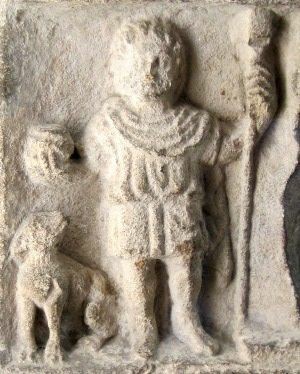
Relief of the Gallic Silvanus on an altar in Nîmes. The god carries his distinctive mallet and olla. A dog is next to him.
Syncretism
At least eleven Sucellus inscriptions are known[5], mostly in Gaul. An inscription (RIB II, 3/2422.21) was found at Eboracum (modern York) in Britain.
Sylvanus
In an inscription found at Augusta Rauricorum (modern Augst), Sucellus is identified with Silvanus[6]:
In honor (em) /d (omus) d (ivinae) deo Su /cello Silv (ano) /Spart (us) l (ocus) d (atus) d (ecreto) d (ecurionum)
The syncretism between Sucellus and Silvanus can also be seen in the work of Narbonne Gaul[7].
Thor
Sucellos bears strong similarities to the Germanic god Thor.
Archaeologist Jean-Jacques Hatt puts forward two possibilities:
• The resemblances between the two gods could result from a common origin dating from the Bronze Age, when the partition between Celtic or pre-Celtic cultures on the one hand and pre-Germanic on the other hand is not yet clear between North Germany. South and West[1]. The separation between the two groups would then date from the beginning of the Iron Age, more precisely from the peregrinations of the Hallstattian warriors, bearers of the long sword[1].
• Another possibility, at a much lower period (3rd-2nd century BC), the Gallic Sucellos could also have contaminated the Germanic Thor like the Celtic Teutates the Germanic Odin[1].
Hatt also notes that these two theories are not exclusive, an ancient Celtic-Germanic origin of Sucellus and Thor, as between Teutates and Odhin, could have facilitated exchanges and syncretisms between the two pantheons, the Germanic and the Celtic[ 1].
A god of life and death
He is the only Gallic god who has a somewhat infernal character[4].
Like the Irish Dagda, Sucellos kills and resurrects with his mallet, which he holds in his left hand. He stands straight, his foot resting on a barrel, a symbol of survival.
He is the Gallic equivalent of the Irish god Dagda, but not an exact replica. Indeed, as a dispenser of wealth, protector of crafts and agriculture, he falls under the third productive function (the other two being the priestly class of druids, and the class of warriors), whereas Dagda, in the Irish tradition, belongs to the first function, called priestly.
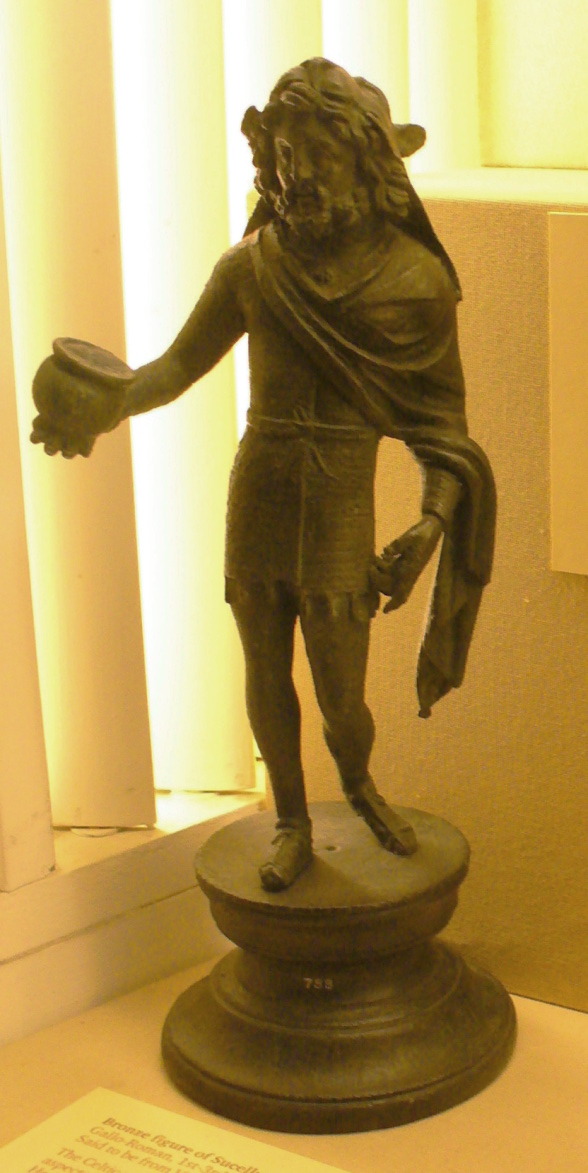
The sucellus of vienna
A god of crops and herds
Sucellos is a rural deity, a pastoral god, protector of crops and herds[8]. Sucellos is a "provider of food[9]" god. He is the holder of prosperity, symbolized by that other attribute which is the cauldron, in his right hand. He is a god of nurturing nature, forests and plantations[10]. Sucellod is also considered like the god of beer

Beer ad (consume in moderation)
Her consort is Nantosuelte, which is a representation of fertility. Sucellos and Nantosuelte are associated on an altar discovered in Sarrebourg and on which we can read the following inscription:
Deo Svcello /Nantosvelte /Bellavsvs Mas /se Filivs V(otum).S(olvit).L(ibens).M(erito).
This can be translated: "For the god Sucellos and Nantosuelte, Bellausus, son of Massa, willingly and rightly fulfilled his vow."
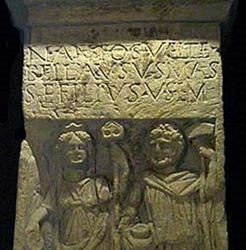
Altar of Sucellos and Nantosuelte in Sarrebourg.
Sucellos seems to have been particularly honored in the Rhineland and in the eastern part of Gaul, in Narbonne, during the Gallo-Roman period. An inscription has also been found in Britain.
• He was assimilated to the Roman god Sylvain, god of vegetation[12], especially in Gaul Narbonne.
• Paul-Marie Duval hypothesized a closeness to another Latin sovereign god, Dis Pater[13].
• Anne Lombard-Jourdan analyzes it as an avatar of the god Cernunnos[14].
• Strong links between Sucellos and Thor have also been put forward[1].
• Bernard Sergent compares him to Vishvakarma.
-------------------------------------------------------
contrary to what I could see as absurd, his feast day does not take place on November 11, the date dedicated to Thor, but his celebrations in Gaul took place on March 20 or 21, days of the spring equinox because he was a Agrarian God who largely dispensed food to men, he was celebrated with the aim of having good harvests in the year.
---------------------------------------------------------
Notes and references
• 1 / ↑ a b c d e and f Jean-Jacques Hatt, Myths and Gods of Gaul, vol 2
• 2/ ↑ Paul-Marie Duval, The Gods of Gaul, Paris, Payot, 1993, p. 62.
• 3/ ↑ Xavier Delamarre, Dictionary of the Gallic Language, Paris, Errance, 2003, p. 113, 282, 283 (ISBN 2-87772-237-6).
• 4/↑ a and b Paul-Marie Duval, Great Gods of Gaul [archive], Publications of the French School of Rome, Year 1989, 116, pp. 223-234
• 5/ ↑ Jufer and Luginbühl (2001), p. 63.
• 6/ ↑ AE 1926, 00040 [archive]
• 7/ ↑ Duval (1993), p. 78.
• 8/ ↑ Félix Guirand, General Mythology, ed.
• 9/ ↑ Paul-Marie Duval, The Gods of Gaul, p. 63.
• 10/ ↑ Jean-Paul Persigout, Dictionary of Celtic Mythology, ed. of the Rock, p. 280, Monaco, 1985, (ISBN 2-268-00968-8)
• 11/ ↑ Philippe Voluer, The Big Book of Beer in Alsace, Editions Place Stanislas, 2008. p23
• 12/ ↑ Record of the National Archaeological Museum, Saint-Germain-en-Laye.
• 13/ ↑ Paul-Marie Duval, The Gods of Gaul, p. 64.
• 14/ ↑ The origins of Carnival, ed. Odile Jacob, Paris, 2005, p.196 (ISBN 2-7381-1637-X).
Bibliography
• Stéphanie Boucher, "The image and functions of the god Sucellus", in The world of images in Gaul and neighboring provinces, Caesarodunum, 23, 1988, p. 77-85.
• Paul-Marie Duval, The Gods of Gaul, Paris, Payot, 1993, 169 p. (ISBN 2-228-88621-1)
• Bernard Sergent, "Sucellus and the barrel", in Marco V. García Quintela, Francisco J. González García and Felipe Criado Boado dir., Anthropology of the Indo-European World and material culture. Proceedings of the 5th international Colloquium of Anthropology of the Indo-European World and comparative Mythology, Budapest, Archaeolingua, 2006, p. 61-80.
• Raymond Christinger and Willy Borgeaud, Ancient Swiss Mythology, Geneva, Georg-Musée d'Ethnographie de la Ville de Genève, 1963, 318 p. (pages 147-214)
#sukellos#sucellos#celtic god#dieu celtique#alban eilir#équinoxe printemps#druidisme#druidism#gallish god#gallic god#dieu de la fertilité#dieu gaulois#celtic mythology#mythologie celtique#spring equinox#spring#ostara
35 notes
·
View notes
Text
Spring gardening day!
No pics bc it’s just dirt in pots rn but planted some onion, garlic, leek, radish, rainbow carrots, coriander, basil, dahlias, and a bunch of edible flowers
Would have done some peas and propogated some pumpkin seeds too but ran out of dirt :-(
21 notes
·
View notes
Text
Spring Equinox 2021
Today is Spring Equinox; one of the balance points of the year where neither day nor night hold sway. Ahead there is more sunlight than darkness, new growth and warmth. May we all find some light in ourselves today, to lift our moods and illuminate our paths. A view of the stream in the wood, with a songbird and magpie soundtrack.
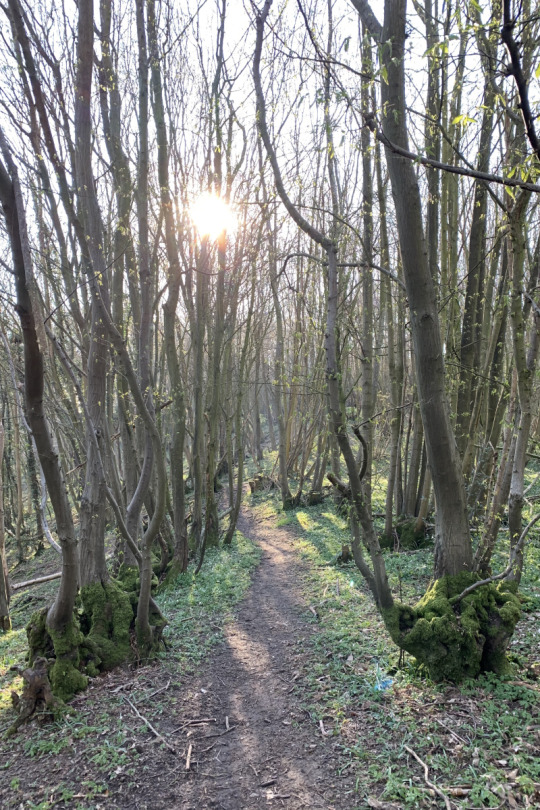
View On WordPress
11 notes
·
View notes